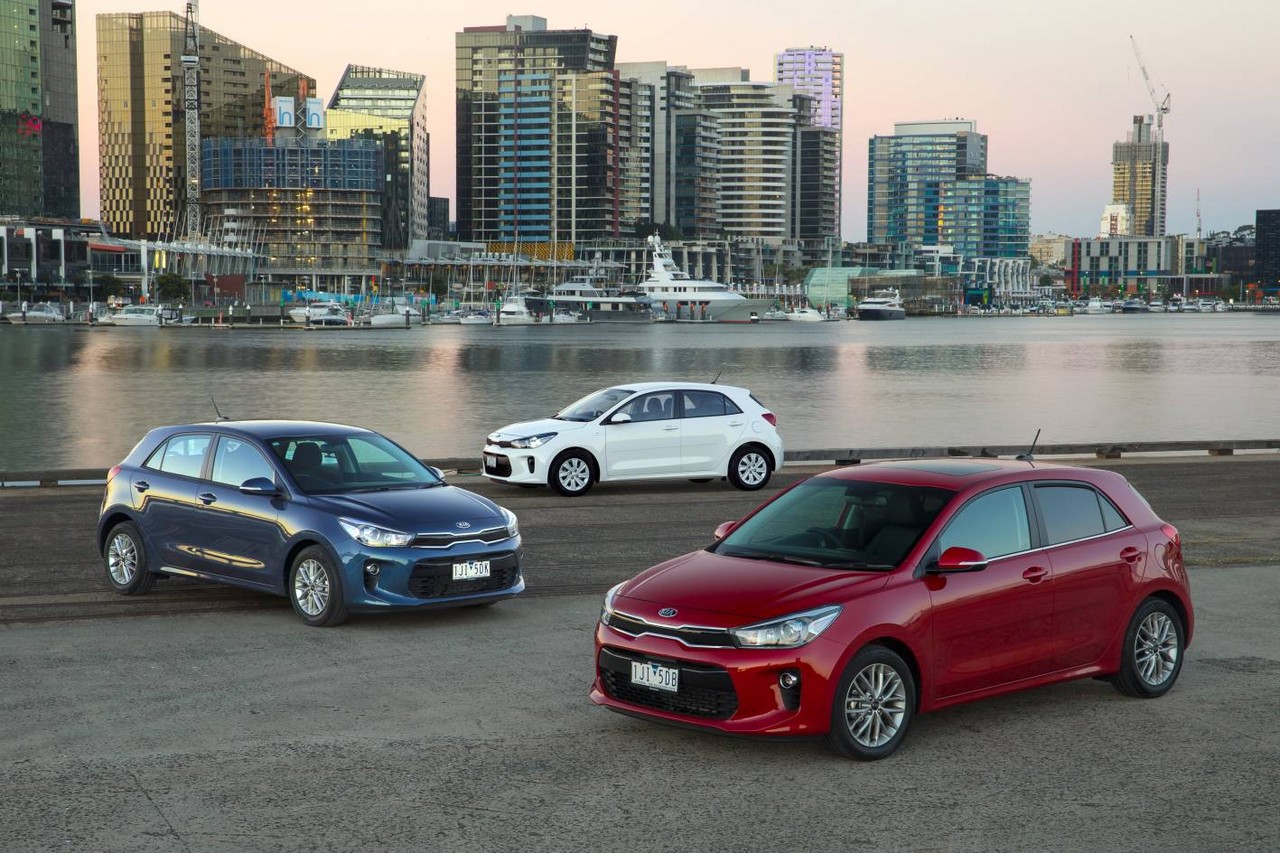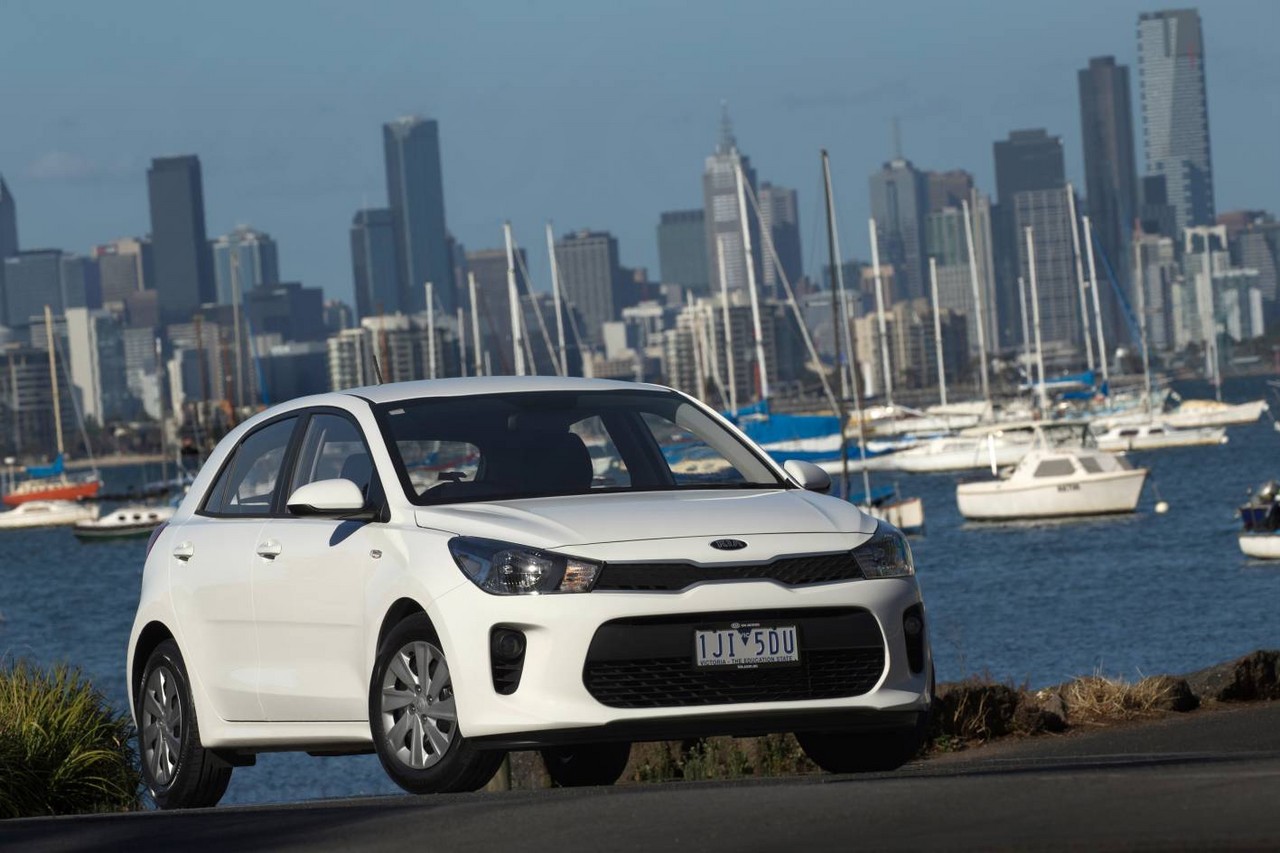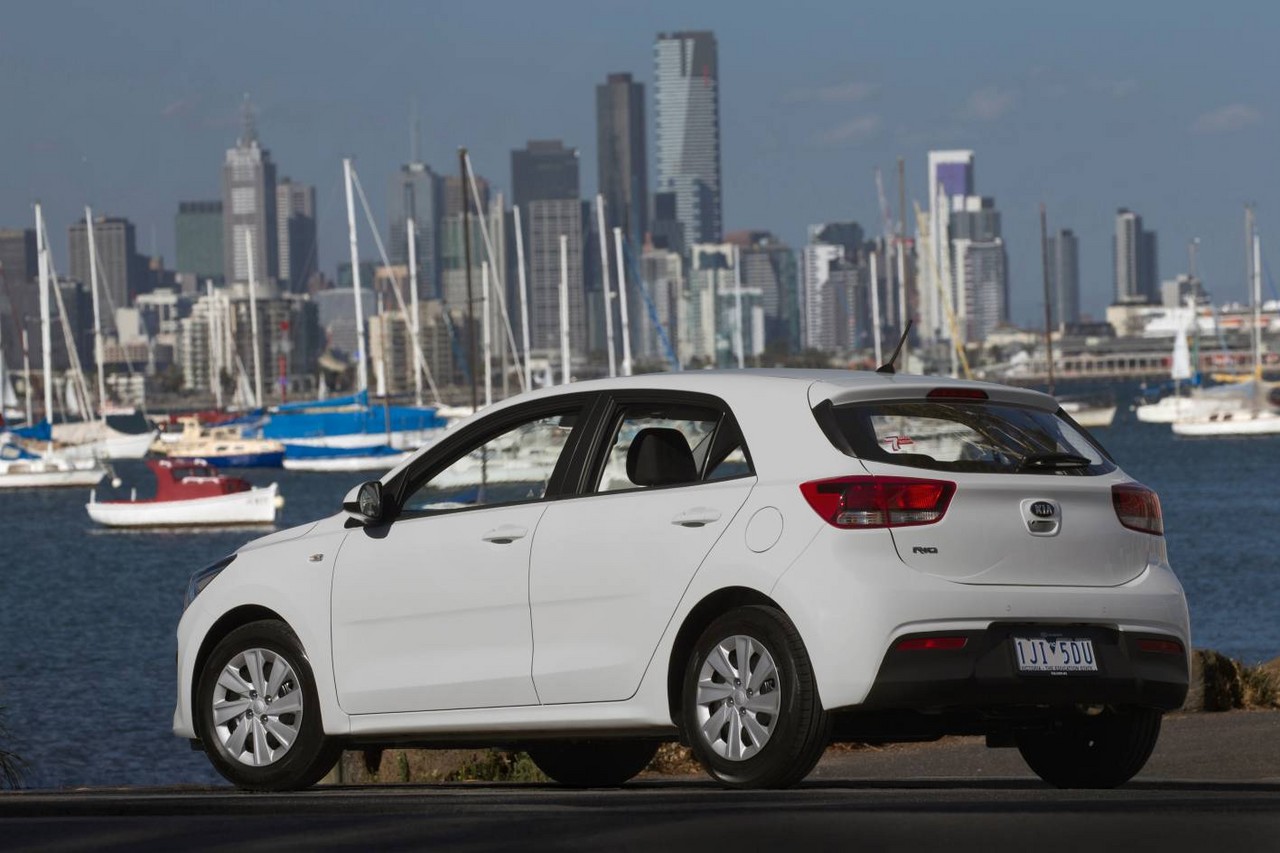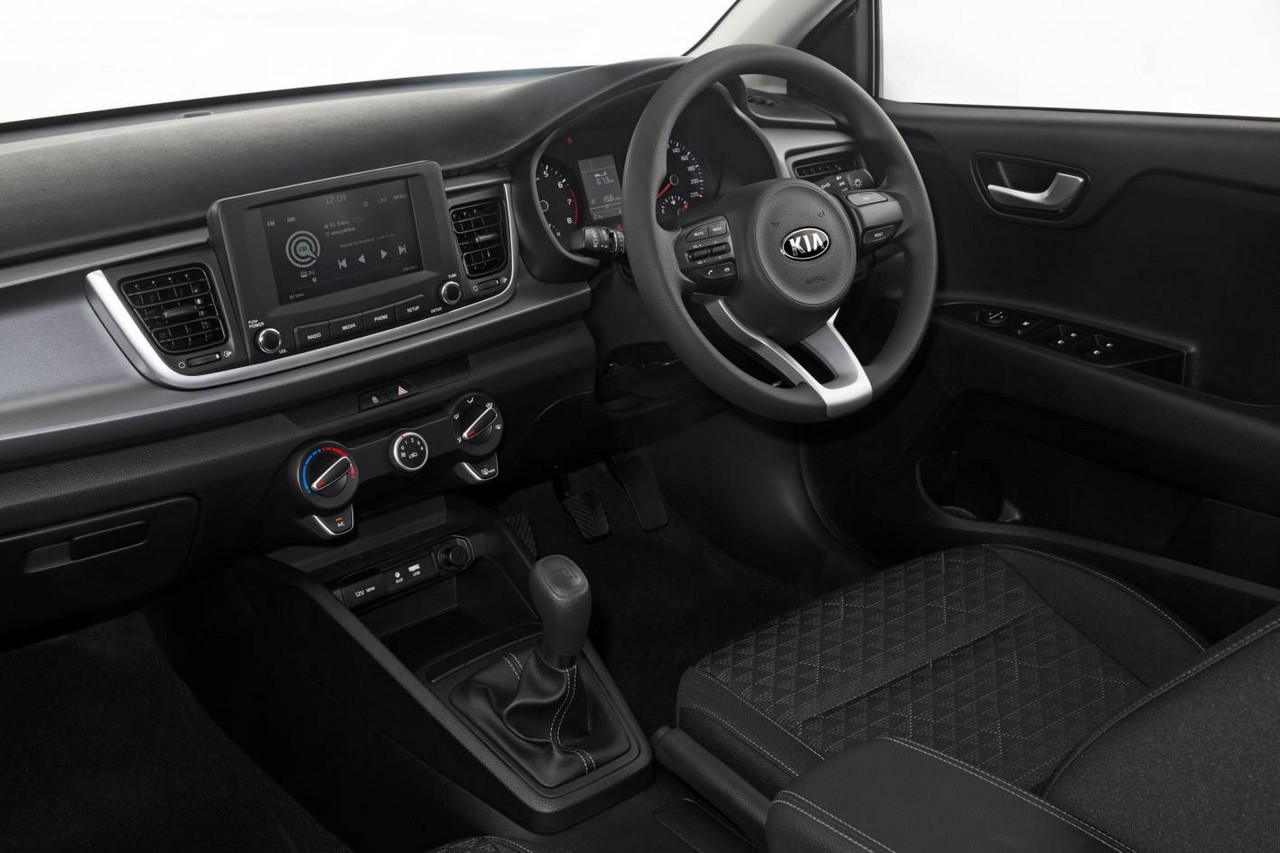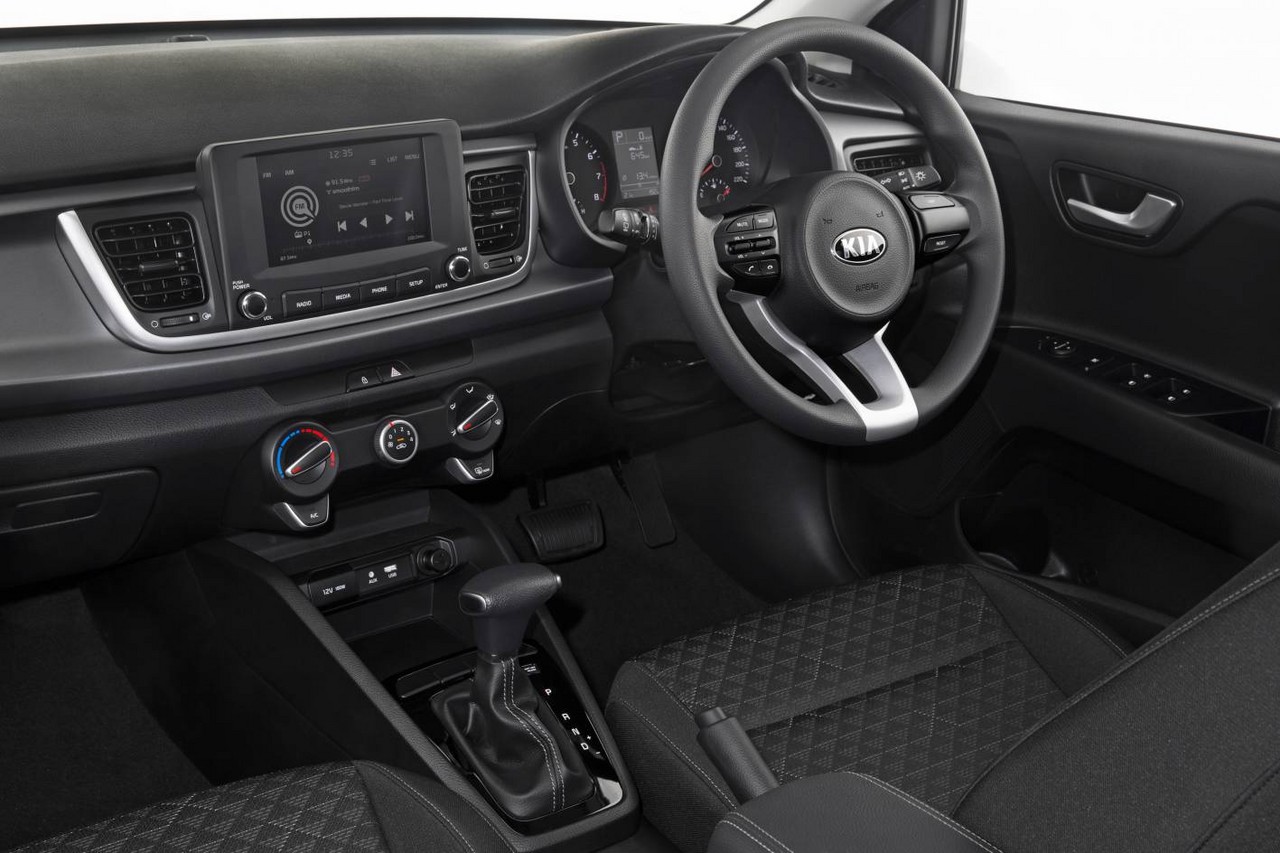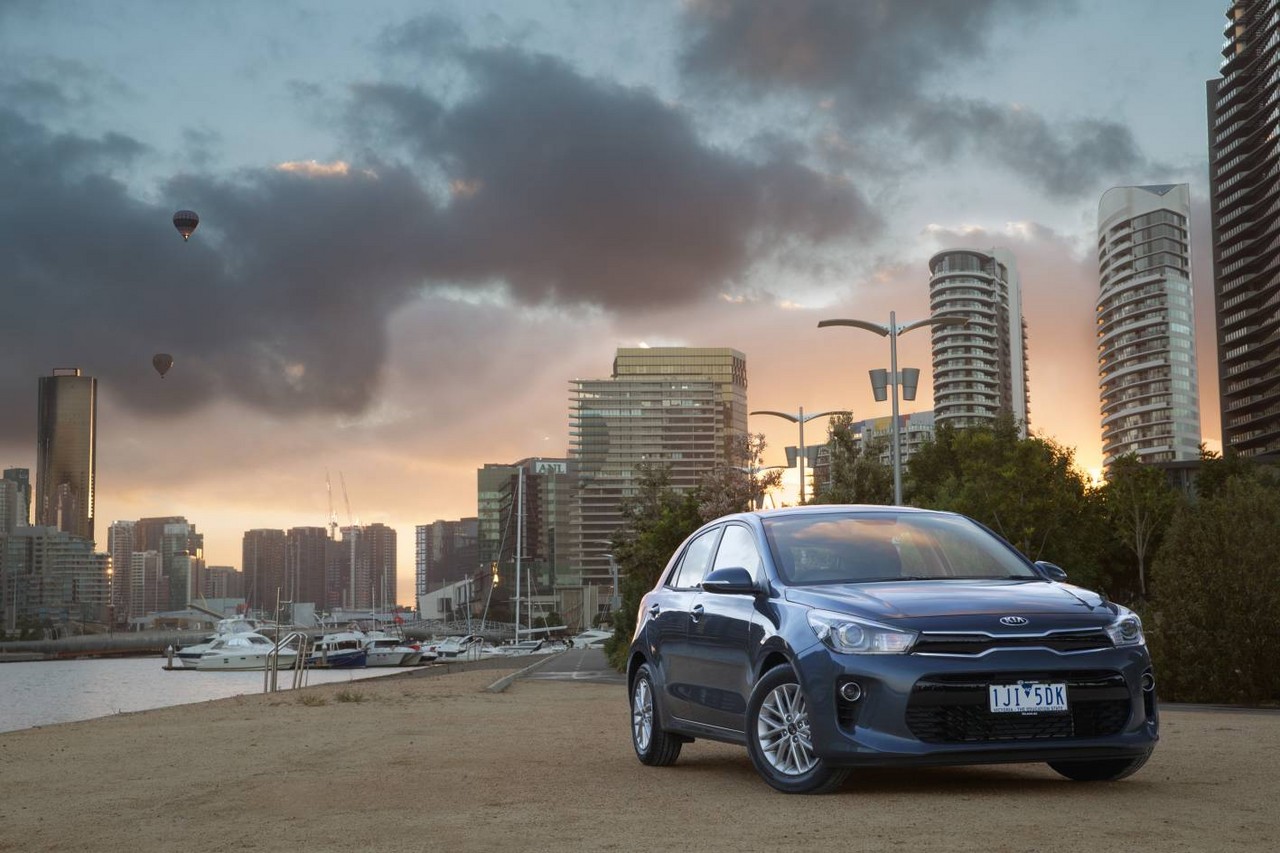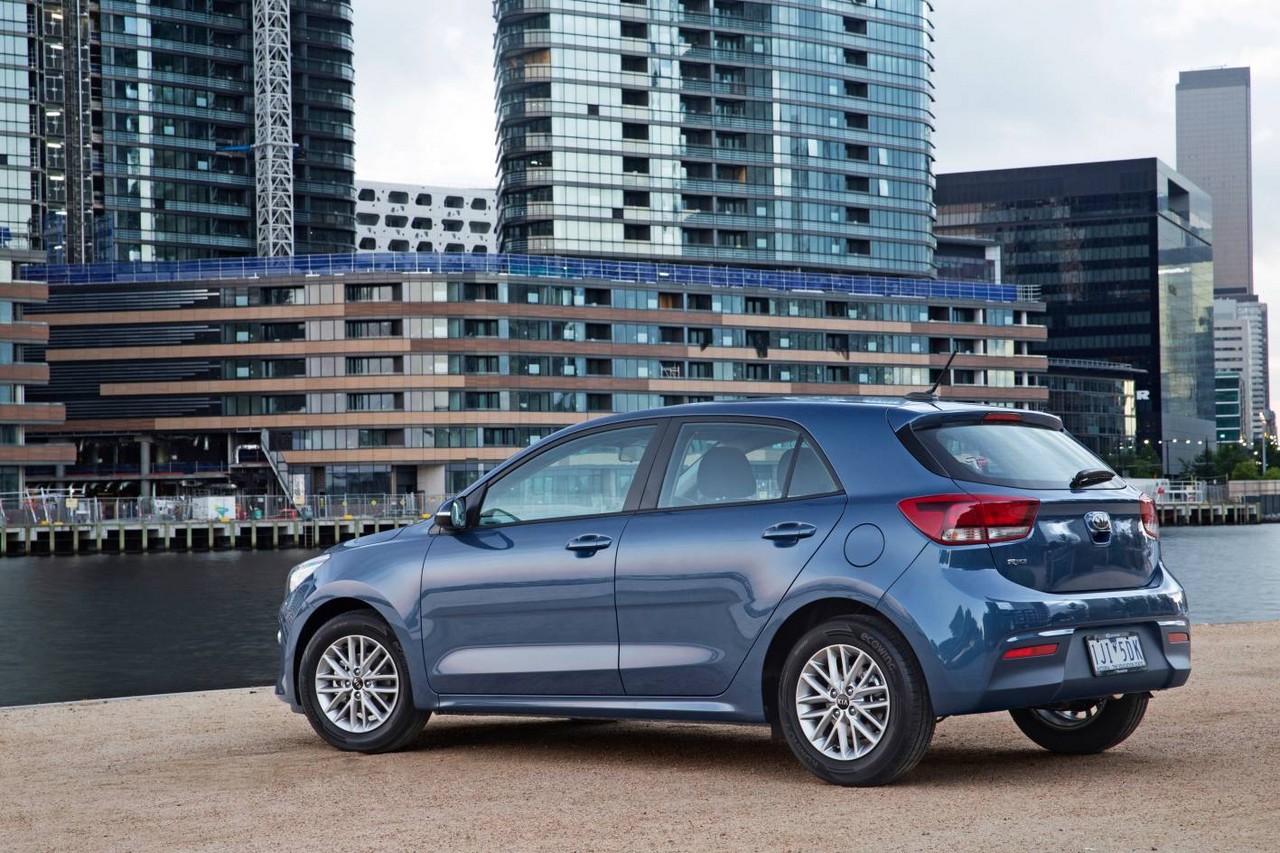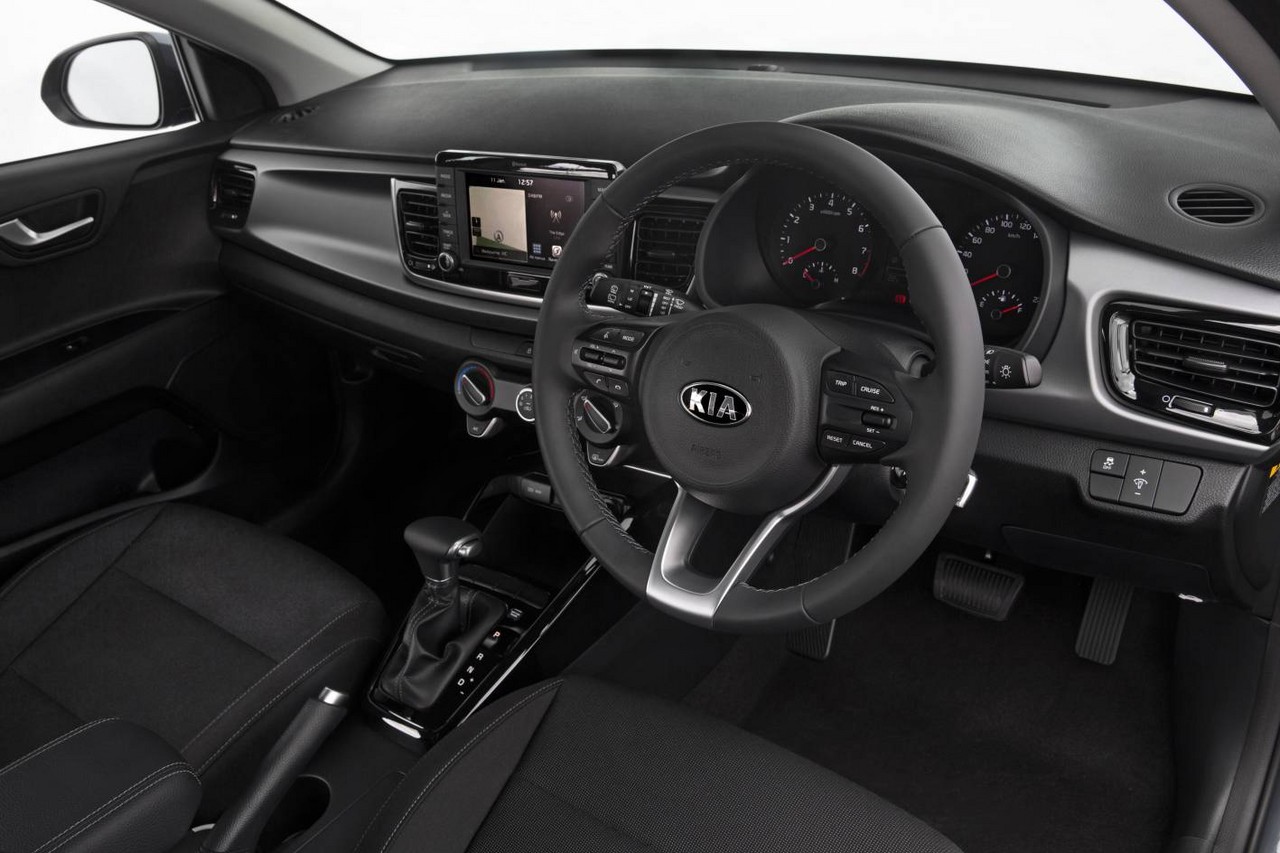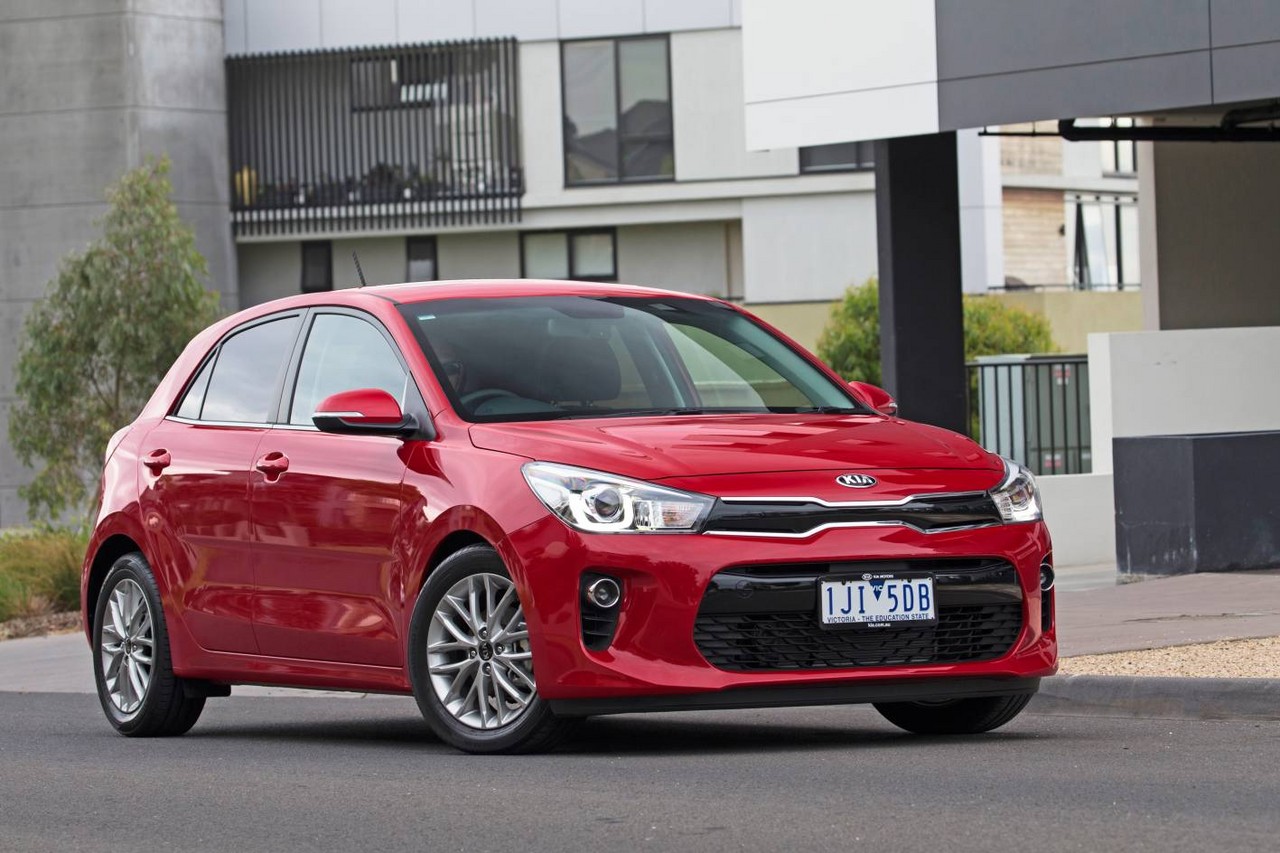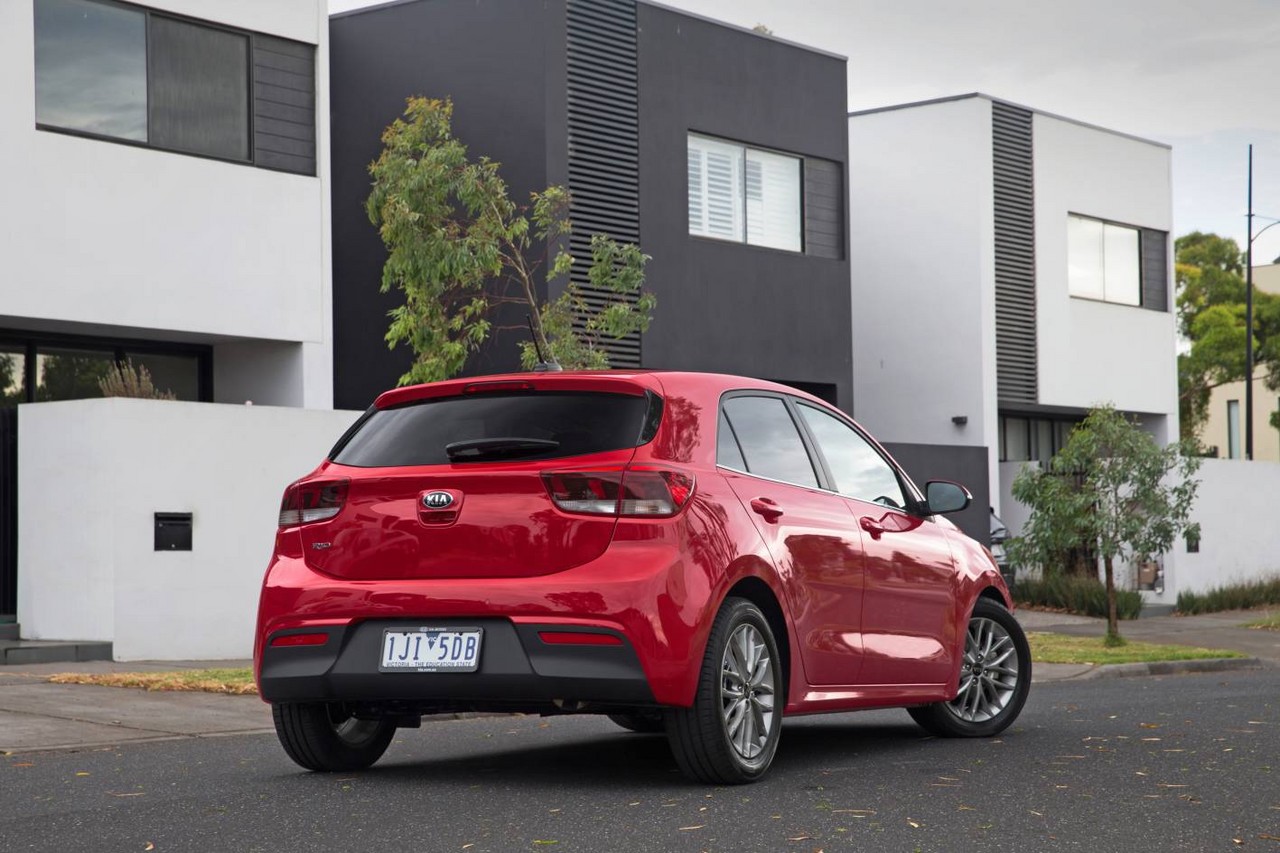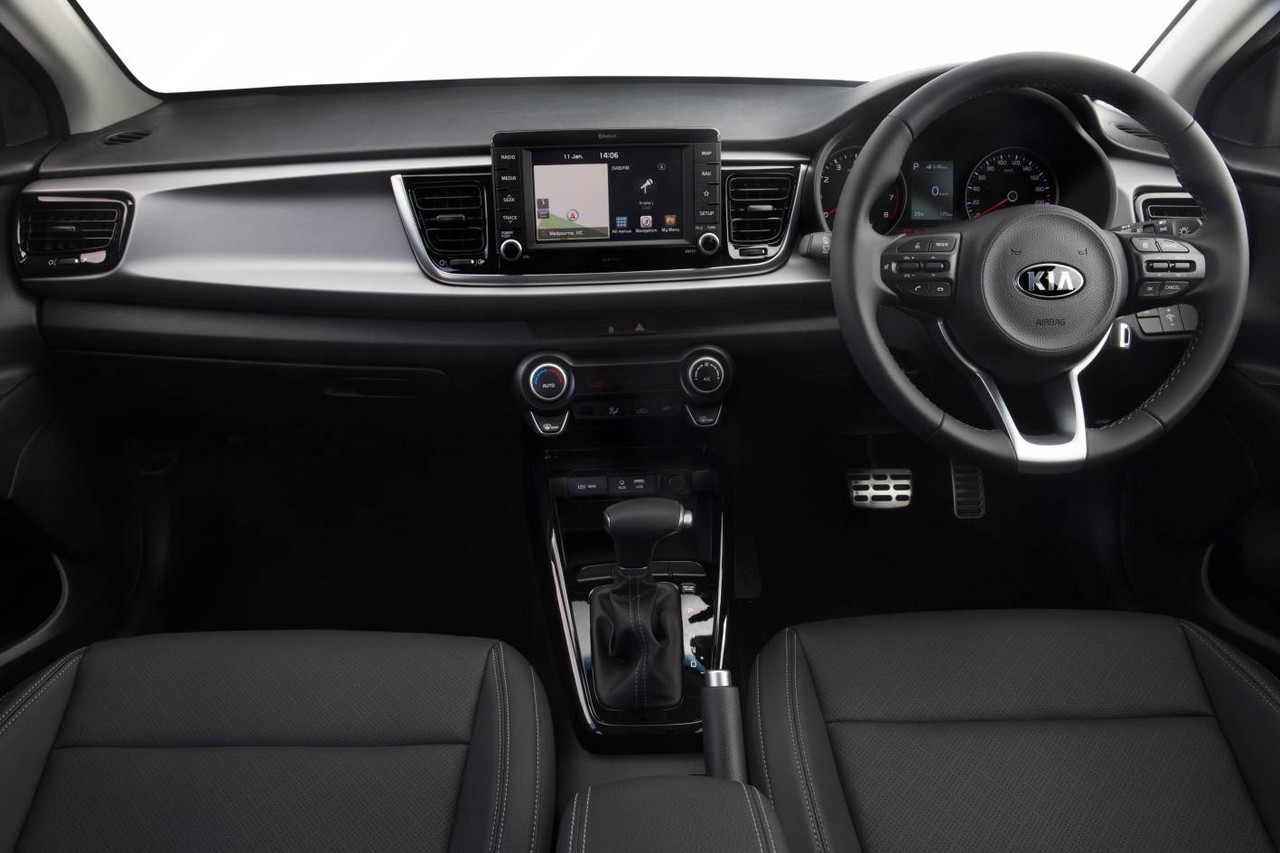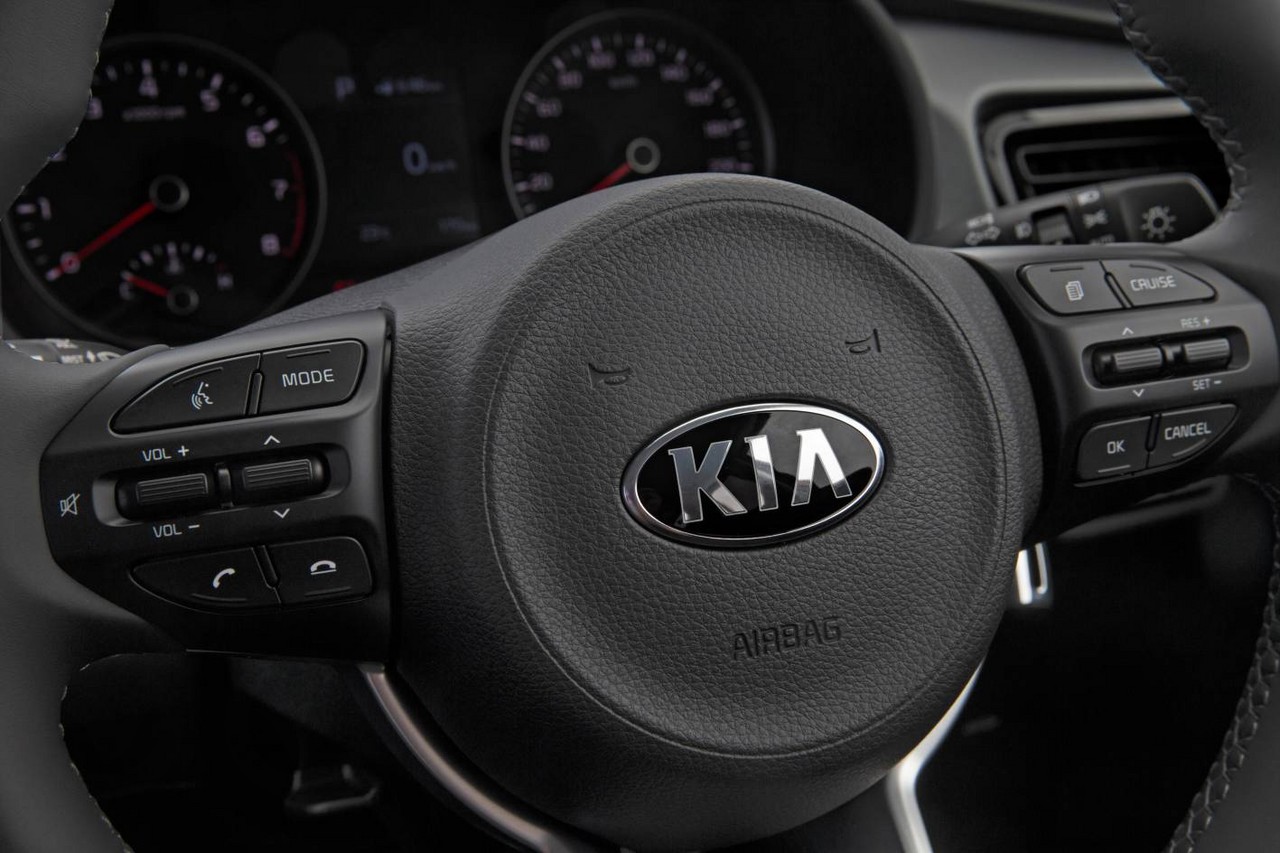
- Economical 1.4-litre G4LC petrol engine
- Comfortable ride and accomplished dynamics
- Modern interior with seven-inch LCD and smartphone compatibility; navigation for Rio Si and SLi
- Engine lacks low-rev torque; four-speed automatic transmission further hinders performance
- Cabin lacks sound insulation
- Autonomous Emergency Braking (AEB) only available on Rio GT-Line
- Moving the cabin backwards has foregone interior space, particularly for rear passengers
Overview
Released in Australia in December 2016, the Kia YB Rio was a light, five-door hatchback. Manufactured at Kia’s Sohari plant in South Korea, the front-wheel drive Kia YB Rio was powered by a 1.4-litre petrol engine that was mated to either a six-speed manual or four-speed automatic transmission. Upon its release, the YB Rio range consisted of S, Si and SLi variants.
In October 2018, the Kia YB Rio range was revised as the Si and SLi were effectively replaced by a Sport variant and a range-topping GT-Line variant was introduced. Unique within the range, the Rio GT-Line was powered by a 1.0-litre three-cylinder turbocharged petrol engine that was mated to a seven-speed double clutch transmission.
G4LC petrol engine
Powering the Kia Rio S, Si, SLi and Sport, the 1368 cc G4LC four-cylinder petrol engine was a member of Hyundai-Kia’s ‘Kappa’ engine family. The engine had a die-cast aluminium block with an integrated ladder-frame for stiffness, 72.0 mm bores and an 84.0 mm stroke, cast-iron cylinder liners, an offset crankshaft, an aluminium alloy cylinder head, double overhead camshafts (chain-driven), four valves per cylinder with beehive valve springs and actuated by roller cam followers, dual continuously variable valve timing (i.e. for intake and exhaust valves), multi-point injection and a compression ratio of 10.5:1.
| Engine | Variant | Years | Trans. | Peak power | Peak torque |
|---|---|---|---|---|---|
| 1368 G4LC cc petrol I4 | S | 2017-on | 6sp man., 4sp auto |
74 kW at 6000 rpm | 133 Nm at 4000 rpm |
| Si, SLi |
2017-18 | 4sp auto | |||
| Sport | 2018-on | 6sp man., 6sp auto |
|||
| 998 cc G3LC turbo petrol I4 | GT-Line | 2018-on | 7sp DCT | 88 kW at 6300 rpm | 172 Nm at 1500-4000 rpm |
Dimensions and body
Compared to the Kia UB Rio , the Kia YB Rio was 20 mm longer (at 4065 mm), 5 mm wider (1725 mm), 5 mm lower (1450 mm) and had a 10 mm longer wheelbase (2580 mm); luggage capacity increased by 37 litres to 325 litres (VDA method).
For the Kia YB Rio, 51 per cent of the body was made from Advanced High Strength Steel (AHSS), an increase of 18 per cent relative to the UB Rio. According to Kia, AHSS was used to reinforce the A- and B-pillars, side sills, roof structure, engine bay and floor. With the manual transmission, the Kia Rio had an unladen mass of 1137 kg.
Suspension
The Kia YB Rio had MacPherson strut front suspension and a torsion beam rear axle. For Australia, the YB Rio was fitted with RS damper valves which enabled Kia’s Australian ride and handling team to fine tune suspension settings.
Compared to the Kia UB Rio , changes for the YB Rio’s suspension included:
- More rigid front suspension struts and cross member;
- A raised rear torsion beam for high-speed stability; and,
- New vertical rear shock absorbers and front shock absorbers with ‘pre-loaded linear valve technology’ for more linear handling and suspension response over broken road surfaces.
Steering
The Kia YB Rio had rack-and-pinion steering with electric power assistance (Kia’s ‘motor-driven power steering’ or MDPS). Relative to the UB Rio, the power steering gearbox for the YB Rio was re-positioned for greater ‘on-centre’ feel through the steering wheel. Furthermore, the Kia Rio had a turning circle of 10.2 metres.
Safety equipment
Standard safety equipment for the Kia YB Rio included dual front airbags, front seat-mounted side airbags, full-length curtain airbags, ABS, electronic brake force distribution, brake assist, electronic stability control, traction control and front seatbelts with pre-tensioners and load limiters.
As standard, the Kia Rio GT-Line was equipped with the following active safety technologies –
- Forward Collision Assistance (FCA) with Autonomous Emergency Braking (AEB): used a radar sensor to monitor the distance to obstacle ahead of the vehicle. If a collision risk was detected, the driver would receive audible and visual alerts. If the driver failed to respond to the these alerts, the brakes would be applied autonomously to reduce vehicle speed so that collisions could be avoided or their severity reduced;
- Lane Keeping Assist (LKA): monitored the Stinger’s position within its lane and provided an audible alerts and steering inputs to maintain the vehicle’s position; and,
- Driver Attention Alert (DAA): monitored driver behaviour and provided visual and audible warnings if signs of fatigue were detected.
ANCAP crash testing
In ANCAP crash testing , the Kia YB Rio received a five star occupant protection rating with an overall score of 35.52 out of 37 – this result did not consider the absence of Autonomous Emergency Braking. In the frontal offset test, protection of the driver’s head, thighs and feet were rated as good, though chest and lower leg protection was rated as adequate (i.e. a slight risk of serious injury). Furthermore, maximum points were awarded in the side impact and pole tests.
Euro NCAP testing
In Euro NCAP testing , the Kia YB Rio – without the ‘Advanced Driving Assistance Pack’ which included Autonomous Emergency Braking (AEB) – received a three star safety rating which included an 85 per cent adult occupant protection rating and an 84 per cent child occupant protection; the ‘safety assist’ rating, however, was 25 per cent. In the frontal offset test, driver protection was rated as good for the neck, thighs and feet, but adequate (i.e. a slight risk of serious injury) for the head, chest and lower legs. In the side impact and pole tests, driver protection was rated as good for all body areas.
Brakes
The Kia YB Rio S, Si, SLi and Sport had 256 mm by 22 mm ventilated front brake discs and 262 mm by 10 mm solid rear discs. The Kia Rio GT-Line differed in that it had 280 mm by 22 mm ventilated front brake discs.
Features: Kia Rio S
Standard features for the Kia Rio S included 6.0J x 15-inch steel wheels with 185/65 R15 tyres, a six speaker sound system with seven-inch LCD, MP3-compatibility, Bluetooth connectivity and auxiliary inputs (3.5 mm/USB/iPod), air conditioning, ‘Tricot’ cloth seat trim, a six-way adjustable driver’s seat (including height adjustment), halogen daytime running lights (DRLs), a rear view camera with dynamic guidelines, rear parking sensors, dusk-sensing headlights, 60:40 split fold rear seats, remote central locking, power adjustable mirrors, power windows, a height and reach adjustable steering wheel, two 12 volt power outlets, two USB charging ports (front and rear) and an immobiliser.
The Kia Rio also featured Android Auto and Apple CarPlay smartphone integration, for Android phones running 5.0 (Lollipop) or higher and iPhone 5 or newer devices, respectively.
As standard, the Kia Rio was fitted with a space-saver spare wheel.
Features: Kia Rio Si and SLi (2017-18)
Compared to the Rio S, the Kia Rio Si was further equipped with 15-inch alloy wheels with 185/65 R15 tyres, digital radio tuner (DAB+), satellite navigation system with live traffic updates (SUNA), cruise control, LED daytime running lights, projector front fog lights, a ‘premium’ steering wheel and gearshift knob, heated and power folding functions for the door mirrors, illuminated vanity mirrors and black high-gloss interior trim.
Visual cues for the Kia Rio Si and SLi included their chrome grille surrounds and door mirrors with integrated indicators.
The Kia Rio SLi was distinguished by its 6.0J x 16-inch alloy wheels with 195/55 R16 tyres, climate control air conditioning, ‘premium’ seats with artificial leather trim, a parking sensor display, rain-sensing wipers, power-operated sunroof, electrochromatic rear view mirror, soft-touch door armrests, alloy sports pedals and rear privacy glass. Visually, the Kia Rio SLi could be identified by its chrome beltline.
Features: Kia Rio Sport and GT-Line (2018-on)
Released in October 2018, the Kia Rio Sport added the following features to the Kia Rio S: 17-inch alloy wheels with 205/45 R17 tyres, cruise control, ‘premium’ steering wheel and gearshift knob, and power adjustable door mirrors with heating function. The door mirrors of the Kia Rio Sport and GT-Line also had integrated indicators.
The range-topping Kia Rio GT-Line was distinguished by its ‘premium’ seats, directional headlights, LED front fog lights, LED daytime running lights, LED rear combination lights, sports steering wheel, rear privacy glass, carbon-fibre look dashboard fascia, illuminated vanity mirrors, ‘supervision’ instrument cluster and alloy sports pedals. Visually, the Kia GT-Line could be identified by its dark chrome grille surround, bodykit, black gloss door mirrors, chrome beltline, rear spoiler, rear diffuser and twin exhaust outlets.
2018 Kia Rio Australian Open Edition
The Kia Rio Australian Open Edition was released in Australia in January 2018. Based on the Kia Rio S, the Rio Australian Open Edition added 17-inch alloy wheels, cruise control, door mirrors with integrated indicators and a ‘premium’ steering wheel and gearshift knob. Local deliveries of the Kia Rio Australian Open Edition were limited to three hundred (300) vehicles that had a drive-away price of $17,777.
Related links
- Brochure: Kia YB Rio (January 2016)
- Specifications: Kia YB Rio (October 2018))
- Behind the Wheel: 2017 Kia Rio S Review
